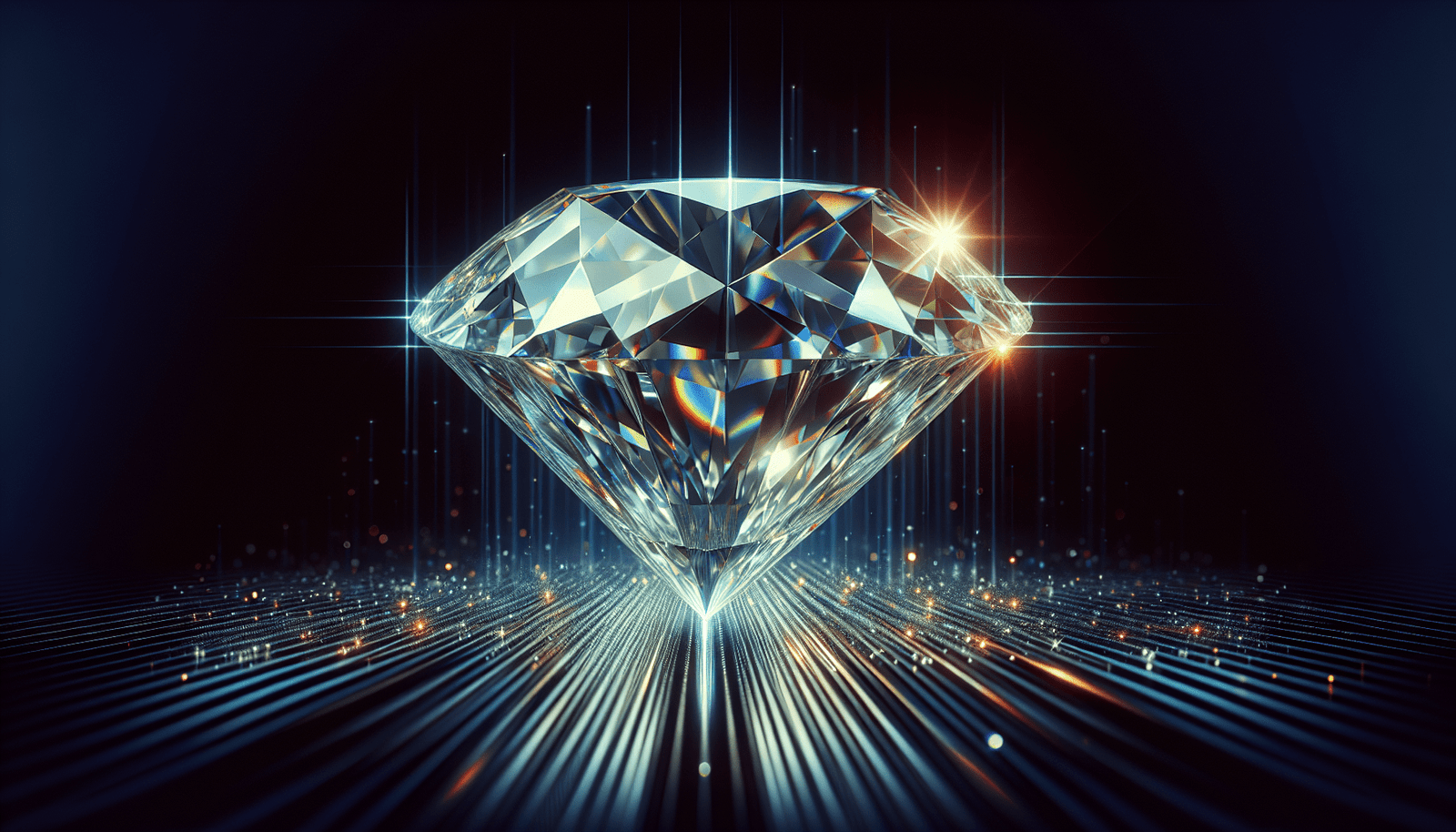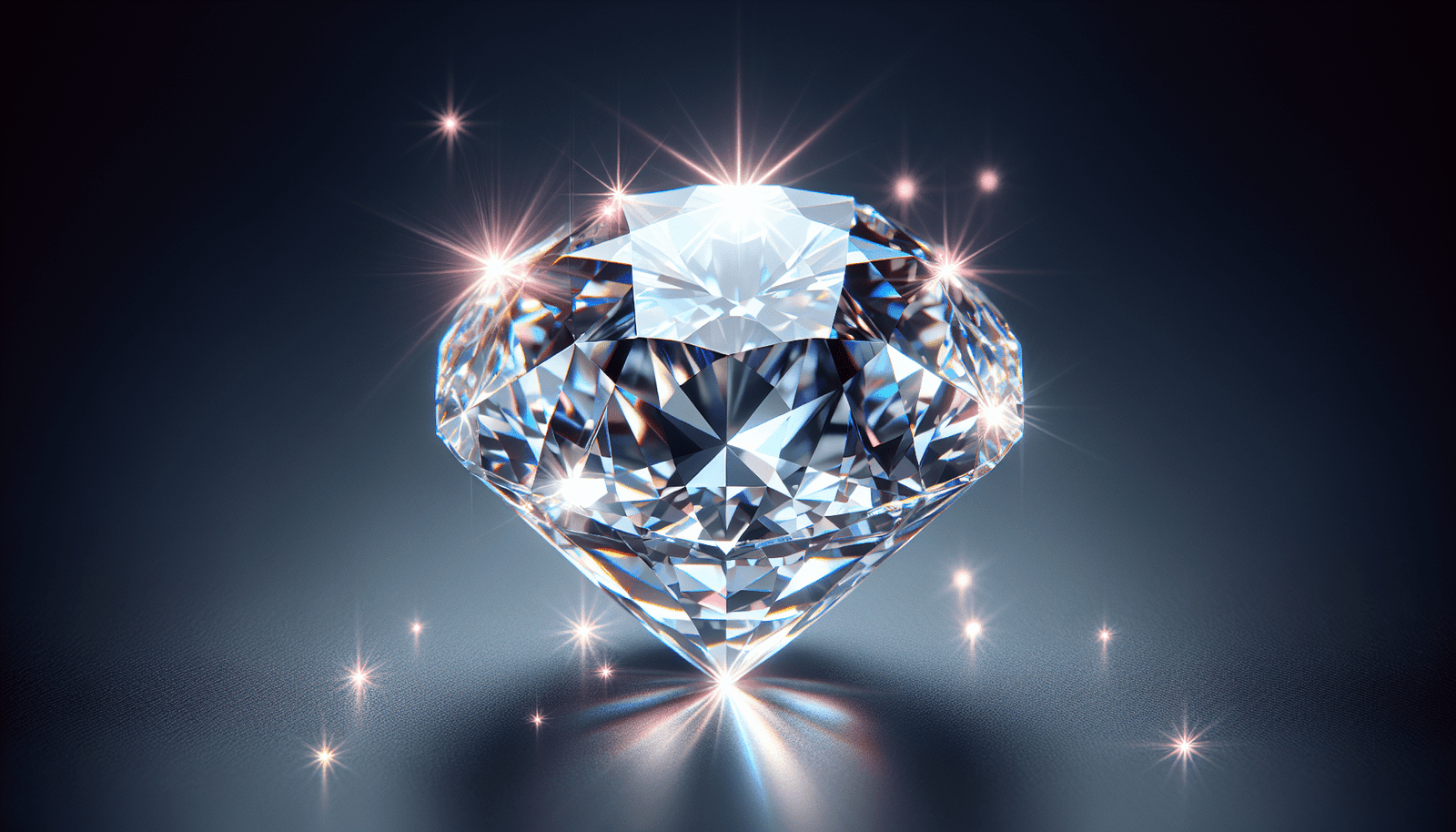Have you ever wondered what makes a diamond sparkle with such mesmerizing intensity? The allure of a diamond goes far beyond its stunning visual appeal; it’s rooted in fascinating science. What kind of elements is diamond 💎, really? Let’s dive into the intricate details of these precious stones and uncover their secrets with a friendly, conversational tone.

The Building Blocks of Diamonds
A diamond isn’t just a shiny rock. It’s an extraordinary gemstone made entirely of one element—and that’s carbon. Yes, that same carbon found in something as mundane as pencil lead! So, how does such a common element transform into something so breathtaking?
Carbon: The Element of Life and Luxury
Carbon is one of the most versatile elements on the periodic table. It has unique bonding properties, allowing it to form various structures, including diamonds and graphite. While we often encounter carbon in everyday forms, its real magic is revealed under extreme conditions.
Chemical Symbol and Atomic Number
Carbon’s chemical symbol is “C,” and it has an atomic number of 6. This means every carbon atom contains six protons in its nucleus. It’s this simple yet versatile element that forms the backbone of diamonds.
Table: Basic Information about Carbon
| Property | Detail |
|---|---|
| Chemical Symbol | C |
| Atomic Number | 6 |
| Element Category | Non-metal |
| Atomic Weight | 12.01 u |
| Electron Configuration | [He] 2s² 2p² |
The Different Forms of Carbon
Carbon is the key player in both diamonds and graphite, but these substances are miles apart in terms of their properties. How can the same element be both a dull, soft material and a dazzling, hard gem?
Allotropes of Carbon: Graphite vs. Diamond
Carbon exists in different forms known as allotropes. The two most well-known allotropes of carbon are graphite and diamond. While they are composed of the same element, their atomic structures make them vastly different.
Table: Comparison of Graphite and Diamond
| Property | Graphite | Diamond |
|---|---|---|
| Appearance | Opaque, black, or grey | Transparent, colorless |
| Hardness | Very soft | Hardest known natural material |
| Electrical Conductivity | Conducts electricity | Does not conduct electricity |
| Atomic Structure | Layers of hexagonal lattices | Tetrahedral lattice |
Atomic Structure of Diamonds
The beauty and resilience of diamonds are due to their atomic structure. Basically, diamonds form a crystal lattice structure where each carbon atom is bonded to four other carbon atoms in a tetrahedral configuration.
Covalent Bonds: Strong as Could Be
In this arrangement, each carbon atom forms strong covalent bonds with four other carbon atoms. Covalent bonds are one of the strongest types of chemical bonds, making the diamond incredibly hard and durable.
Unique Geometric Arrangement
This tetrahedral structure means that diamonds have a repeating pattern that extends in three dimensions, creating an incredibly strong, rigid lattice that gives diamonds their unique properties.
Formation and Origin of Diamonds
You might be asking yourself, “Where do diamonds come from?” Nature creates these precious gems in the most unyielding environments, miles beneath the Earth’s surface.
Natural Formation vs. Synthetic Creation
Diamonds can form naturally or be created synthetically. Let’s explore each process to understand their similarities and differences.
Natural Formation in the Earth’s Mantle
Natural diamonds form under extreme temperature and pressure conditions, around 90 to 150 miles beneath the Earth’s surface, in the mantle. At these depths, temperatures range between 1652 and 2372 degrees Fahrenheit, and pressures are over 725,000 pounds per square inch.
Kimberlite and Lamproite Pipes
Diamonds are transported closer to the Earth’s surface through volcanic pipes known as kimberlite and lamproite pipes. These allow the diamonds to travel rapidly before being deposited near the surface where they can be mined.
Synthetic Diamonds
In contrast, synthetic diamonds are created in laboratories using techniques that mimic natural conditions. There are two primary methods:
- High-Pressure High-Temperature (HPHT): This mimics the natural formation process by applying high pressure and temperature to carbon.
- Chemical Vapor Deposition (CVD): This involves breaking down carbon-containing gas molecules in a vacuum chamber to form a diamond layer.
Myths and Misconceptions
There are numerous myths surrounding the formation and durability of diamonds. For instance, it’s a common belief that diamonds are “unbreakable.” While they are incredibly hard, making them resistant to scratches, they are not indestructible. A sharp blow can chip or break a diamond due to its rigid atomic structure.
Table: Myth vs. Reality About Diamonds
| Myth | Reality |
|---|---|
| Diamonds are indestructible | They are the hardest natural substance but can chip if struck correctly |
| Diamonds form from coal | They typically form in the Earth’s mantle, far deeper than where coal forms |
| All diamonds are colorless | They can come in various colors depending on impurities |

The Unique Characteristics of Diamond
Apart from their sparkling appearance, diamonds possess several unique characteristics that set them apart from other minerals and gemstones. These properties have made diamonds valuable not only as jewelry but also in various industrial applications.
Hardness: The Mohs Scale
The hardness of a mineral is measured on the Mohs scale, which ranks minerals from 1 (talc) to 10 (diamond). Diamonds are rated at a 10 on this scale, making them the hardest known natural material. This hardness is why diamonds are commonly used in cutting, grinding, and drilling tools.
Optical Properties
The way a diamond interacts with light contributes significantly to its sparkle and fire. These optical properties are a result of its unique atomic structure.
Refractive Index
A diamond’s refractive index is 2.42, which is very high. This means that it bends light rays to a significant degree, causing the light to slow down and change direction as it moves through the diamond.
Dispersion
Dispersion refers to a diamond’s ability to split white light into its constituent colors. This is what gives diamonds their rainbow-like flashes of color, often referred to as “fire.”
Table: Key Optical Properties of Diamond
| Property | Value |
|---|---|
| Refractive Index | 2.42 |
| Dispersion | 0.044 |
| Luster | Adamantine |
Thermal Conductivity
Believe it or not, diamonds are excellent conductors of heat, outperforming even metals like copper. This property is due to the strong carbon-carbon bonds and the crystal lattice structure, which allow vibrations (phonons) to travel through the diamond with minimal resistance.
Electrical Insulation
Despite their exceptional thermal conductivity, diamonds are poor conductors of electricity. This contradiction arises because the electrons in a diamond are tightly bound in covalent bonds, restricting their movement and inhibiting electrical conductivity.
Diamonds in Technology and Industry
While diamonds are often associated with luxury jewelry, their unique properties make them invaluable in technology and industry.
Cutting and Drilling Tools
Due to their hardness, diamonds are used in cutting, grinding, and drilling tools. Diamond-tipped tools are essential for cutting through tough materials like other stones, concrete, and even metals.
Heat Sinks
Diamonds’ excellent thermal conductivity makes them ideal for heat sinks in electronic devices. A heat sink dissipates heat away from sensitive components, preventing overheating.
Semiconductor Applications
Although diamonds are generally insulators, certain synthetic diamonds can be engineered to act as semiconductors. This has potential applications in electronics, particularly for devices that require high thermal conductivity and electrical insulation.
Medical Equipment
Diamonds are also used in medical equipment, particularly in cutting and grinding tools for surgeries. Their precise and durable nature makes them ideal for delicate procedures.

The Grading and Valuation of Diamonds
When you think about buying a diamond, factors such as cut, color, clarity, and carat weight (the 4 Cs) come to mind. These factors determine both the aesthetic and monetary value of the diamond.
Cut
The cut of a diamond affects its brilliance and sparkle. A well-cut diamond reflects light in such a way that it maximizes its natural luster and fire. Poorly cut diamonds may appear dull despite their innate potential.
Clarity
Clarity refers to the absence of inclusions and blemishes. Inclusions are internal flaws, while blemishes are surface imperfections. Diamonds are graded for clarity on a scale ranging from “Flawless” to “Included,” with varying degrees of inclusions in between.
Table: Clarity Scale
| Grade | Description |
|---|---|
| Flawless | No inclusions or blemishes visible under 10x magnification |
| VVS1, VVS2 | Very, Very Slightly Included; minute inclusions very difficult to detect |
| VS1, VS2 | Very Slightly Included; minor inclusions somewhat difficult to detect |
| SI1, SI2 | Slightly Included; noticeable inclusions |
| I1, I2, I3 | Included; obvious inclusions affecting transparency and brilliance |
Color
While diamonds are often thought to be colorless, they can actually range in color from clear to shades of yellow or brown. The Gemological Institute of America (GIA) grades diamond color from D (colorless) to Z (light yellow or brown).
Carat Weight
Carat weight measures the mass of a diamond. One carat is equivalent to 200 milligrams. While larger diamonds are rarer and often more expensive, a diamond’s value is not determined by carat weight alone. It’s a combination of the 4 Cs that dictates its worth.
Ethical Considerations and Sustainable Practices
In today’s world, ethical considerations play an increasingly important role in the diamond industry. The history of diamonds includes some unsavory aspects such as conflict diamonds, which are extracted in war zones and sold to finance armed conflict.
Conflict-Free Diamonds
Efforts like the Kimberley Process aim to eliminate conflict diamonds from the market. You should look for certification that guarantees your diamond is conflict-free to ensure responsible sourcing.
Lab-Grown Diamonds
Lab-grown diamonds offer a sustainable alternative to naturally mined diamonds. They have the same physical and chemical properties as natural diamonds but come with a lower environmental impact. By choosing lab-grown diamonds, you can enjoy the beauty of this stunning gem with a clear conscience.
Personal and Cultural Significance
Diamonds have captivated humanity for centuries, not only for their physical properties but also for their cultural significance. They symbolize permanence, strength, and unbreakable love. From engagement rings to anniversary gifts, diamonds play a crucial role in marking important life milestones.
Historical Use
Throughout history, diamonds have been associated with power, wealth, and status. Ancient civilizations revered them for their unmatched beauty and purported protective properties. Royals and nobles throughout history adorned themselves with diamonds, and these gems continue to be symbols of luxury and prestige.
Modern Symbolism
Today, diamonds symbolize more than just wealth. They represent commitment and love in the form of engagement rings and wedding bands. The phrase “A diamond is forever,” coined by De Beers in the 20th-century, captures the enduring nature of these stunning stones.
Conclusion
So, What kind of elements is diamond 💎? At its heart, a diamond is an incredible marvel of nature composed solely of carbon atoms arranged in a uniquely strong and beautiful crystal lattice. From their natural formation deep within the Earth or their creation in high-tech labs, to their critical roles in industry and their dazzling presence in the world of fashion, diamonds are far more than just pretty stones.
Understanding the science and complexities behind diamonds can deepen your appreciation for this remarkable gemstone. Whether you’re considering purchasing a diamond or simply curious about these glamorous gems, knowing their background enriches your relationship with them. After all, diamonds are not just a girl’s best friend—they’re everyone’s extraordinary miracle of nature and science.



